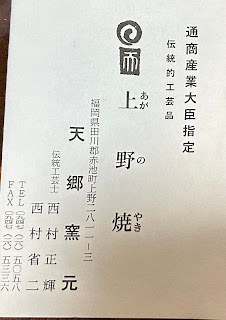Agano Yaki has a history that dates back to 1602. It was one of the seven favored styles of pottery of the great tea master, architect and garden designer Kobori Enshu. It was supported by the clan through the Edo period but when the Meiji period came, and the patronage of the clan was eliminated many wares, like Agano Yaki, disappeared for a while, but were later revived. Agano yaki is probably best known for its blue green glaze with hints of iron spots, but there are other styles as well. The Hongama, or original kiln is Totoki Gama. It usually has the characteristic carved swirl in the foot, along with a postage stamp shaped mark with the Shirakawa Family ____ mark. there are currently (2019) 16 kilns around Tagawa town that produce Agano Yaki.
2025-September
I attended the 46th year of the West Japanese Pottery Festival
西日本陶磁器フェスタ
I met Mr Jōno (城之豊三) of the Jōno kiln. He makes both traditional and modern styles of Agano Yaki.
The more traditional blue/green glazes don’t sell as well these days so many of his works are updated to colors of deeper blues and purples to meet the demands of younger customers.
He was a sumo wrestler but sustained injuries that ended his career. He turned to pottery making, and seems to be a very happy potter. He was very kind and generous to me.
 |
| Me holding cups made by Mr. Jōno. |
 |
| I still adore the more traditional Agano glazes. |
 |
| Agano Yaki Jōno Gama |

**************
 |
| Tea Bowl by Koushin Gama (庚申窯) |
 |
| Agano Bowl |
Mark used by Hosho from c1800, currently used by the Shiragawa /Totoki kilns
****************************************
KOZURU GEN
 |
| Agano yaki tea cup by Kozuru Gen (高鶴元) |
Additional mark of Kozuru Gen
Gen Kozuru wrote the Agano & Takatori volume in the Famous Ceramics of Japan series by Kodansha International in 1981.
Generic Agano Yaki (no marks)
 |
Agano Yaki Futaoki
|
十時窯十一代甫元 白川硯山作 上野焼茶碗
The mark is not clear but may be from the Kozuru kiln
**************************
I believe these are by 15th Kumagae Koyo (熊谷江陽)
Shisō te yū 柴蘇手釉
 |
| Shisō te yū 柴蘇手釉 |
 |
| Kumagai Hongama marks |
AGANO KILNS (some may no longer be producing wares)
Aoyagi Furoen
Fuji gama
Hachiman gama
Hotta gama
Jono gama
Kajiwara gama
Kajiwara hongama
Koshin gama
Koushyu gama
Kouzuru gama
Kumagae hongama
Mamoru gama
Motohiko gama
Muzou gama
Nakamura gama
Seizan gama
Shibanoto gama
Shirakawa gama
Shouryuu gama
Takada gama
Takanashi gama
Tengo gama
Totoki gama
Watari gama
上野窯元 Agano Kamamoto
青柳不老園(あおやぎふろうえん)Aoyagi Furoen
梶原本窯(かじわらほんがま) Kajiwara Hon-gama
梶原窯(かじわらがま)Kajiwara Gama
熊谷本窯(くまがえほんがま) Kumagae Hon-gama
光修窯(こうしゅうがま)Koushyu Gama
庚申窯(こうしんがま)Koshin Gama
高鶴窯(こうづるがま) Kouzuru Gama
柴ノ門窯(しばのとがま)Shibanoto Gama
城之窯(じょうのがま)Jōno Gama
昇龍窯(しょうりゅうがま) Shyouryuu Gama
白川窯(しらかわがま)Shirakawa Gama
清山窯(せいざんがま)Seizan Gama
高田窯(たかだがま)Takada Gama
天郷窯(てんごうがま) Tengou Gama
十時窯(とときがま)Totoki Gama
中村窯(なかむらがま)Nakamura Gama
八幡窯(はちまんがま)Hachiman Gama
不二窯(ふじがま)Fuji Gama
堀田窯(ほったがま)Hotta Gama
守窯(まもるがま)Mamoru Gama
無造窯(むぞうがま) Muzou Gama
元彦窯(もとひこがま)Motohiko Gama
渡窯(わたりがま) Watari Gama


Kōzuru Kazan
 |
Totoki Kamamoto Honkei (original family)
|
There are additional kilns in Kawara town called AGANO KAWARA YAKI
http://aganoyakikawara.wix.com/aganoyaki
Kawara (香春) MARK ( also referred to as Denkō yaki)
*********************************
























































































